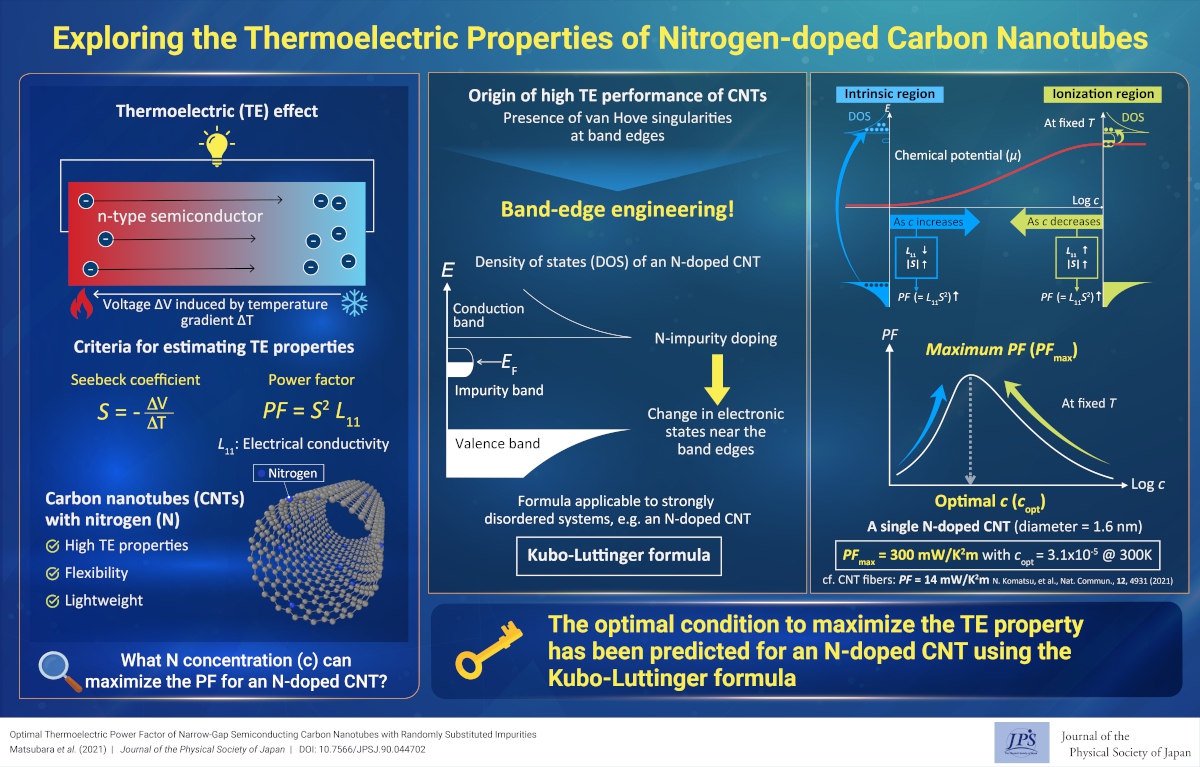Exploring the Thermoelectric Properties of Nitrogen-doped Carbon Nanotubes
© The Physical Society of Japan
This article is on
Optimal Thermoelectric Power Factor of Narrow-Gap Semiconducting Carbon Nanotubes with Randomly Substituted Impurities
J. Phys. Soc. Jpn. 90, 044702 (2021).
A semiconducting carbon nanotube doped with an optimal concentration of nitrogen delivered a thermoelectric power substantially higher than that delivered by commercial Bi2Te3 alloys.

Thomas Johann Seebeck discovered the thermoelectric (TE) conversion from heat to electrical energy just 200 years ago. Recently, high-performance TE materials have attracted research interest as energy-harvesting technologies. Most of the experimentally discovered TE materials are impurity-doped semiconductors i.e., disordered systems. High-TE effects are expected near the band edge in the impurity-doped semiconductors, where the electronic states are under the influence of strong impurity scattering not properly treated by the conventional Boltzmann transport theory (BTT). Therefore, it is necessary to develop a sophisticated theory beyond BTT. Recently, the authors (T.Y. and H.F.) have alleviated this drawback using the linear response theory (Kubo–Luttinger formula) in conjunction with the thermal Green's function technique [1–3].
The TE linear response theory was successfully applied to nitrogen-doped semiconducting carbon nanotubes (N-CNTs) in the present study. The N-CNTs functioned as lightweight, flexible, and high-performance TE materials. The power factor, PF (=L11S2), was dependent on the nitrogen concentration, c (up to 10-2), per unit cell of a CNT at various temperatures. The electrical conductivity and Seebeck coefficient were designated as L11 and S, respectively. The PF increased with a decrease in c at 300 K. When c decreased to less than the optimal impurity concentration, copt (= 3.1×10-5), the PF started to decrease. This behavior was explained based on L11 and S, considering the c-dependence of the chemical potential, μ. The μ at c = 10-3 located below the donor level formed via nitrogen doping, and the electrons were thermally excited from the donor level to conduction band. The μ level shifted downward with a decrease in c owing to a decrease in the net carrier density of the N-CNTs. Here, |S| increased with a decrease in c. A decrease in c, corresponding to a decrease in the rate of scattering by the impurities, was accompanied by an increase in L11 owing to the electrons in the conduction band. Consequently, the PF increased with a decrease in c. A further lowering of c promoted the asymptotic approach of μ toward the center of the band gap owing to the thermally excited holes. The holes contributed to an increase in L11; however, |S| decreased rapidly because the hole contribution to S cancels out the electron contribution to S. Therefore, the PF started to decrease below copt. These results facilitated successful estimation of the optimal nitrogen concentration to maximize the PF at various temperatures. A PF of 0.30 W/K2m was obtained for copt at 300 K, which is significantly higher than the PF of commercial Bi2Te3 alloys. These theoretical predictions will facilitate the development of new materials with optimal TE performances.
(written by M. Matsubara on behalf of all authors)
References
[1] T. Yamamoto and H. Fukuyama, J. Phys. Soc. Jpn. 87, 024707 (2018).
[2] T. Yamamoto and H. Fukuyama, J. Phys. Soc. Jpn. 87, 114710 (2018).
[3] M. Ogata and H. Fukuyama, J. Phys. Soc. Jpn. 88, 074703 (2019).
Optimal Thermoelectric Power Factor of Narrow-Gap Semiconducting Carbon Nanotubes with Randomly Substituted Impurities
J. Phys. Soc. Jpn. 90, 044702 (2021).
Share this topic
Fields
Related Articles
-
Antiferromagnetism Induces Dissipationless Transverse Conductivity
Electronic transport in condensed matter
Magnetic properties in condensed matter
Electronic structure and electrical properties of surfaces and nanostructures
2024-7-24
An investigation using high-quality NbMnP crystals demonstrates that the anomalous Hall conductivity arising from antiferromagnetism is dissipationless, as expected from the intrinsic mechanism.
-
Evaluation of the Exchange Stiffness Constants of Itinerant Magnets from the First-Principles Calculations
Electron states in condensed matter
Structure and mechanical and thermal properties in condensed matter
2024-6-5
Using first-principles calculations, we evaluated the exchange stiffness constants of ferromagnetic metals at finite temperatures. The constants can be used as parameters in the Landau–Lifshitz–Gilbert equation.
-
Exploring Electronic States in BEDT-TTF Organic Superconductors
Superconductivity
Electronic transport in condensed matter
Magnetic properties in condensed matter
2024-4-24
This review, published in the Journal of the Physical Society of Japan, provides a comprehensive summary of the electronic states observed in BEDT-TTF type organic superconductors, including metal-insulator transitions, Mottness transitions, non-Fermi liquids, quantum spin liquids, and Bose-Einstein condensation.
-
Conversion of Chiral Phonons into Magnons in Magnets
Electronic transport in condensed matter
2024-4-1
A new phenomenon involving the conversion of chiral phonons into magnons is theoretically predicted. The effective magnetic field induced by chiral phonons causes a change in the spin magnetization of magnets.
-
Which is Moving?—Pinning Down the Origin of Fluctuations in Muon Spin Relaxation—
Structure and mechanical and thermal properties in condensed matter
Cross-disciplinary physics and related areas of science and technology
2024-3-28
The study demonstrated that we can distinguish between the diffusion motion of the muon itself and the motion of the surrounding ions in muon spin relaxation.
